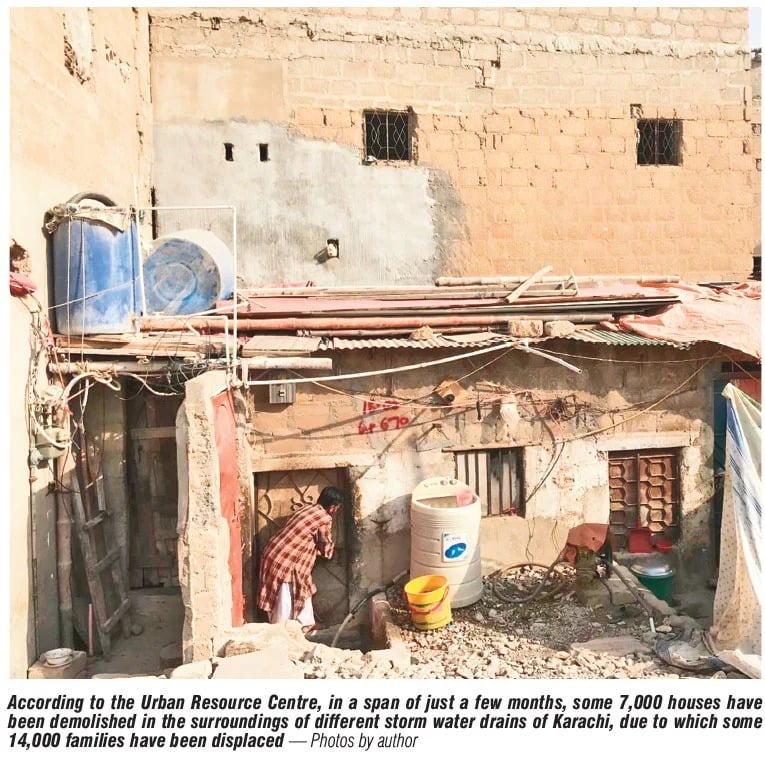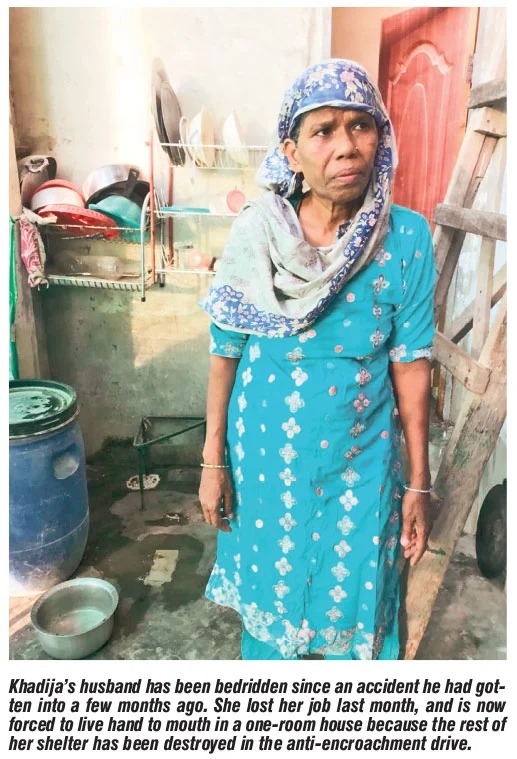During a visit to the Gujjar Nullah’s Sadiq Nagar locality this February, this scribe had found out that all 15-year-old Raj Masih wanted to save was the Santa Claus graffiti he had painted on the boundary wall of his little home, which had been slightly blotted by the Karachi Metropolitan Corporation’s (KMC) marking of encroachments.
A few months later, his entire home was razed to the ground. There is no Santa Claus any more. Raj has shifted to Pahar Ganj with his family. His neighbours recall their last Christmas, when the entire impoverished neighbourhood of Sadiq Nagar celebrated the religious festival with joy, what little of it they could still muster.
On the one end of the Gujjar Nullah is Sadiq Nagar of Gulberg Town, which is populated mostly by the Christian community living alongside Muslims since decades. On the other bank of the storm water drain is North Nazimabad.
Mehreen Maqsood passed her intermediate pre-engineering examination this year. While she was taking her exams, her house was being demolished. She was a student of the Riaz Medical College.
“Every morning when I used to leave for my exam, there used to be a rush of neighbours protesting against the demolitions, and we were just waiting for our turn,” she recalled, adding that she had somehow managed to clear her exams.
Khadija’s husband has been bedridden since an accident he had gotten into a few months ago. She lost her job last month, and is now forced to live hand to mouth in a one-room house because the rest of her shelter has been destroyed in the anti-encroachment drive.
The couple’s only son works at a factory and earns Rs18,000. Her husband has developed bedsores, and the family cannot afford any medical treatment for him.
She said she had bought the house for Rs300,000 and then invested further in its construction, adding that she has all the documents with her, but the authorities have decided to destroy their home anyway.
Her entire one-room house stands on two pillars. “Just yesterday the authorities told us that one of the pillars needs to be removed,” she said, adding that they have taken away everything from them. “I have just one room and a dying husband. Can I have just this much to spend the rest of my life?”
Resident of Rehmanabad Block-5 of the Federal B Area, 29-year-old Shahid walks on the rubble of his home. He has rented a room for his 90-year-old mother in one of the houses around the Gujjar Nullah that has not been demolished yet.
“I have a lease document with me. I go to every hearing of the Supreme Court assuming that this time the chief justice will listen to our woes,” he said, lamenting that nothing happens.
Inside his one-room house, there is a bed, a TV set, two fans, and a blood pressure apparatus and sugar testing machine. There is also a faulty wall clock affixed to a shabby wall.
The KMC has been tasked with widening the storm water drain to its original shape and width, along with the construction of a 30-foot-wide road on both sides of the nullah, due to which scores of Katchi Abadis will have to be razed.
The Gujjar Nullah is a natural drain in the city starting from New Karachi and ending at the Chuna Depot in Haji Mureed Goth, where it falls into the Lyari River. The original length of the nullah was 13 kilometres and it was 210 feet wide.
The Urban Resource Centre (URC) had arranged a field trip for reporters on Saturday to show them the settlements surrounding the Gujjar Nullah that were being demolished. According to the URC, in a span of just a few months, some 7,000 houses have been demolished in the surroundings of different drains of the city, due to which some 14,000 families have been displaced. The SC has ordered rehabilitating the residents, but nothing has happened till now.
This project — the rehabilitation of the families affected by the Orangi Town Nullah and Gujjar Nullah anti-encroachment operations — is worth Rs10 billion, the implementation of which would be the responsibility of the provincial government, according to the verdict of the Sindh High Court.
It has also been said that the Sindh government would, on a priority basis, fulfil all the legal and administrative protocols to complete the task.
The high court has further instructed the government to portion out Rs1 billion in the ongoing year from a range of means at its disposal, while for the remainder of the value, the provincial government must arrange the funds within two years.
Published In The News By Oonib Azam 31 October 2021

